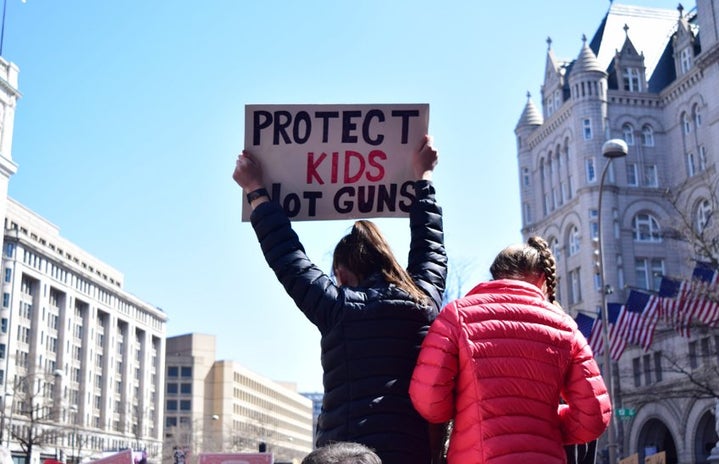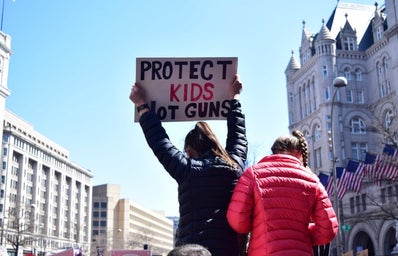Gun violence is the new normal in America. Every day, there seems to be at least one new mass shooting, prompting grief and messages of “thoughts and prayers,” but no real action. In 2023 so far (literally less than two months), there have been 80 mass shootings, resulting in at least 70 deaths and 167 injuries. In 2022, there were a whopping 647 mass shootings and 44,306 deaths from gun violence as a whole, which includes all murders, suicides, and unintentional deaths. But in a country with more guns than people (120.5 guns per 100 residents), what do we expect? This number is more than 2x higher than every other country in the world, and our gun death rate is also higher than any other developed country. The U.S. also ranks number two worldwide in gun-related suicides. While mass shootings are certainly a tragic part of the gun violence issue— with more than 600 mass shootings every year since 2020— the problem extends so much further, to matters of suicide, domestic violence, and unintentional deaths.
Gun violence has become a widespread concern for Americans, as 75% of people view gun violence as a major problem and 57% of people are in favor of stricter gun laws. In the wake of the recent Michigan State University (MSU) shooting, the increasing prevalence of personal experience with gun violence (especially among younger generations) became abundantly clear. Some MSU students have now lived through two mass shootings, surviving past tragedies like the Oxford High School and Sandy Hook Elementary School shootings. Schools should be a safe place for students to learn without fear of getting murdered, but sadly, this is no longer the case. For instance, the recent Robb Elementary School shooting shook the community in Uvalde, Texas after 19 children and 2 adults were murdered, and 17 more were injured. Valentine’s Day this year marked the 5-year anniversary of the Marjory Stoneman Douglas High School shooting, where 17 people were killed and 14 were wounded. Survivors are left forever traumatized, with many now serving as fierce advocates for gun safety reform. Children are dying, yet nothing is being done to stop it. In 2022 alone, 1676 children and teens died and 4485 were injured as a result of gun violence. Additionally, firearms are now the leading cause of death among people younger than 24, which is due to an increased rate of firearm suicides, homicides, and accidental deaths. Improper gun storage has resulted in almost 350 children unintentionally shooting themselves or someone else every year. And, 74% of school shooters obtained the firearm from their own home, or the home of a friend or relative.
So, why is there so much gun violence in the U.S.? According to Harvard researchers, one reason is the significant power of the gun lobby, which has effectively resulted in the entire field of gun violence research being neglected and hardly funded. In 2022 alone, the National Rifle Association (NRA) spent $731,099 on campaign contributions, $2,630,000 on lobbying, and $14,018,091 on outside spending for their PAC and SuperPAC, which focus on getting pro-gun candidates elected. Clearly, the NRA has tremendous influence on politics, and therefore gun control legislation. Gun violence is currently viewed as an extremely partisan issue, despite the fact that it impacts all of us, regardless of political party. Mass shootings have occurred at churches, schools and grocery stores, all places with often diverse groups of people. Children can injure or even kill themselves and others due to the lack of safe gun storage. Anyone, even you or someone you love, can become a victim of gun violence. So, the relentless politicization is useless. A common fear is that the government wants to take people’s guns away, which is untrue. The goal is to implement common sense gun laws to make living with guns safer, and to get deadly weapons out of the hands of dangerous people. More than ⅓ of mass shooters were prohibited from possessing firearms at the time of the shooting, but were able to access guns in the absence of comprehensive federal law requiring background checks on ALL gun sales around the country. This allows criminals, abusers, and other prohibited people to easily avoid background checks in 29 states by buying guns from unlicensed sellers.
Now that we have a good grasp on the gun violence issue, how can we fix it? In 2022, a bipartisan gun safety bill was passed, which included enhanced background checks for gun buyers between 18 and 21 years old, provided grants for states to enact “red flag” laws that allows guns to be temporarily confiscated from dangerous people, created a law prohibiting domestic abusers from purchasing guns (which is important because 53% of mass shootings from 2009-2020 involved domestic violence), and allocated hundreds of millions of dollars for school safety and mental health, among other things. While this bill was certainly a step in the right direction, there is still more work to be done. The bill did not ban assault weapons or high-capacity magazines, despite the fact that assault weapons and large-capacity led to 6x and 5x as many people shot per mass shooting, respectively. From 2009-2020, the 5 deadliest mass shootings– Las Vegas music festival (59 deaths and 500 injuries), Orlando Pulse Nightclub (49 deaths and 53 injuries), Sandy Hook Elementary (26 deaths and 2 injuries), Sutherland Springs church (26 deaths and 20 injuries) and El Paso Walmart (22 deaths and 24 injuries)– all involved the use of assault weapons and/or high capacity magazines. With the problem of mass shootings, research has shown that fewer mass shootings occur in states with bans on large-capacity magazines, and the shootings that did occur in those states killed fewer people. Banning the purchase of large-capacity magazines and ammunition-feeding devices for semi-automatic weapons is particularly impactful, as these devices allow the shooter to fire countless bullets (sometimes upwards of 100 rounds of ammunition) without interruption. If shooters have to stop and reload, this allows time for victims to potentially escape or fight back. These types of guns, large-capacity magazines and ammunition feeding devices are solely used to kill as many people as possible in the shortest amount of time, and are not useful in hunting or any other recreational use of guns. Therefore, it follows that a ban would increase safety, without infringing upon the rights of responsible gun owners.
Additionally, keeping guns away from young people, which could involve safe storage of firearms in a home or age restrictions on purchasing, is also expected to have a protective effect, as the peak age for gun violence is roughly 18-21 years old. However, due to the lack of funding of gun violence research, there is not conclusive evidence to fully support this yet. Research also suggests that making it easier for people to carry guns in public for self-defense is an ineffective strategy; if anything, higher rates of fatal mass shootings occur in response to weaker regulations for concealed carry by civilians. “Red flag” or extreme risk laws have also been found to be effective in saving lives, which applies to issues like suicide as well. From 2009-2020, 56% of mass shooters exhibited dangerous warning signs (i.e., engaging in recent threats of violence, violating a protection order, etc.) prior to the shooting, which resulted in 596 deaths and 260 injuries that could have been prevented. As mentioned previously, closing loopholes in our federal and state background check laws is also expected to greatly increase safety.
While many of these solutions require widespread political change, individuals still play a crucial role in advancing gun safety reform. “We have been overdue for a change since the first mass shooting happened,” MSU junior Phebe Jones said. “There is no reason any person should have to deal with this for any reason. The most help we can ask for is protesting. No more thoughts and prayers. Actions speak louder than words. Rise up and speak for those that can’t anymore. Offer any sort of support you can. Being quiet will not help us.”
If you or someone you know is experiencing suicidal thoughts, call the National Suicide Prevention Lifeline at 1-800-273-8255. You can also text the Crisis Text Line by texting HELLO to 741741.
Her Campus USFSP would like to extend a special thank you to Phebe Jones and the MSU chapter of Her Campus. We greatly appreciate their contribution to the article, and more importantly, we stand with MSU.


